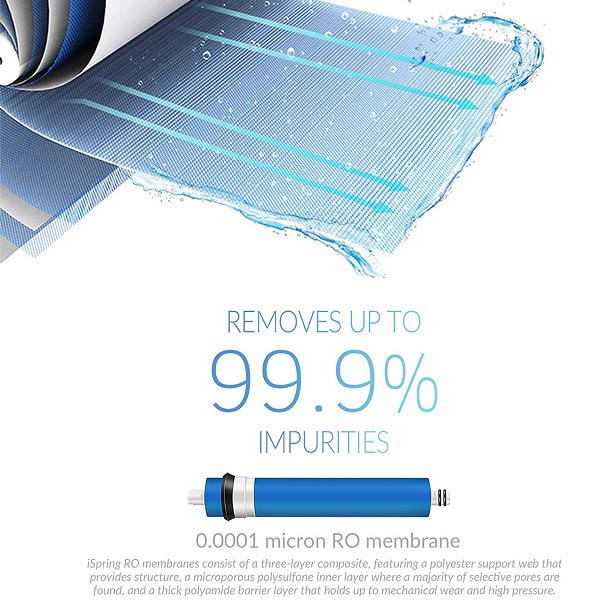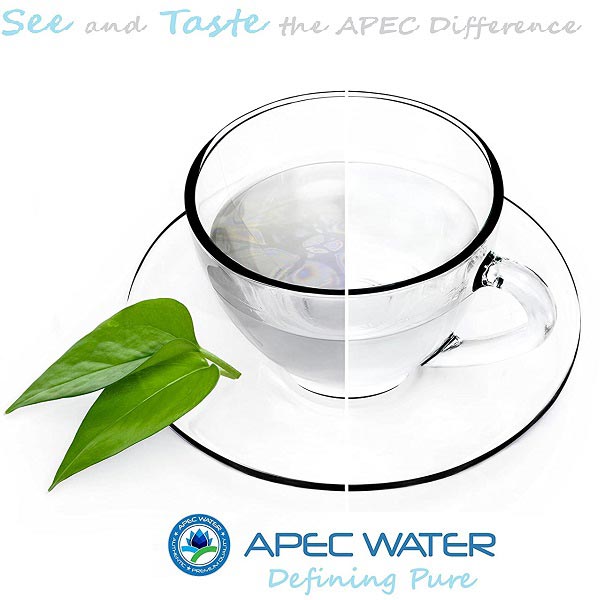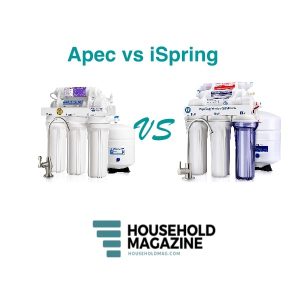Who is iSpring and Apec?
The iSpring water systems have been focused for 20 years to provide you with clean, healthy water through updated water filtration systems that are easy to use.
They provide both residential and commercial systems intending to give clean drinkable water at an affordable price.
In keeping with the same standard, iSpring RCC7 is one of the best seller products.
On the other hand, APEC water systems have been in the water filtration industry for over two decades and are considered one of the best in the United States.
Similar to iSpring, the APEC ROES-50 is one of the best reverse osmosis water systems in the market.
In this review, we will be looking at two categories:
iSpring RCC7 VS APEC ROES-50 Comparison
| Image | PRODUCT/ Features | Rating | |
|---|---|---|---|
WINNER |
iSpring RCC7Weight: 20 pounds Water Pressure: 45-70 pounds per square inch Water Capacity: 75 gallons a day Storage Tank Capacity: 3.2 gallons Temperature: 40 -100 degrees Fahrenheit Number of Filters: 5 stage filters Filters lifespan: 3 to 6 months for 1st-3rd stage 1 year for 5th stage 2-3 years for 4th stage Price: $189.99 Average Maintenance Cost: $30 Customer Rating: 4.7 out of 5 stars Warranty: 1 year Dimensions: 15 x 8 x 18 inches Installation: DIY |
|
|
 |
APEC ROES-50Weight: 25 pounds Water Pressure: 40-85 pounds per square inch Water Capacity: 50 gallons a day Storage Tank Capacity: 4 gallons Temperature: 40 -100 degrees Fahrenheit Number of Filters: 5 stage filters Filters lifespan: 6 to 12 months for 1st-3rd stage 2-3 years for 5th stage 2-3 years for 4th stage Price: $199.95 Average Maintenance Cost: $40 Customer Rating: 4.8 out of 5 stars Warranty: 1 year Dimensions: 16 x 5.25 x 17.5 inches Installation: DIY |
|
The Spring RCC7 is an under sink mount RO system that requires an under sink installation. This reverse osmosis water filtration system comes with a 5-stage filtration system.
The APEC ROES-50 is produced and assembled in the United States. It is a reverse osmosis water filtration system that comes with a five-stage filter process for water purification.
The APEC ROES-50 reviews speak for themselves declaring APEC as a leading water system in America.
Filtration System
The RCC7 has 5 stage different filters all equipped to perform differently.
The first filter is a 5-micron pre sediment removal filter. This is designed to remove any contaminants that are divisible to the eye but are too minute to remove yourself.
These substances and impurities include sand, dust, rust, and other smaller impurities.
The second and third filter contains a carbon block filter and an activated carbon filter. Carbon is used in most systems to remove chlorine, unpleasant tastes, and bad odors from your tap water supply.
The fourth stage is a deeply refined RO membrane. This reverse osmosis filter removes up to 95% of total dissolved solids undetected to the invisible eye.
Total dissolved solids include inorganic salts alongside other organic matter that may already be present in your water supply.
These include substances like fluoride, calcium, asbestos, lead, magnesium, and other heavy metals, etc.
The fifth and last filtration system is the post-carbon filter that gets rid of any bad tastes and odors left behind.
Unlike the iSpring RCC7, the first stage of the APEC ROES-50 is a 5-micron polypropylene sediment filter. This filter removes the standard dust, sand, and rust as well as other contaminants that aren’t visible to the naked eye.
Stage two and three include an activated carbon block filter to remove chlorine, odor, bad tastes, etc. The APEC ROES-50, however, has a double carbon filter screening that makes sure major chemicals are removed to increase the life of other filters and the RO membrane.
The fourth stage includes the 0.0001 micron RO membrane. This membrane eliminates the same materials as the iSpring RCC7; dissolved solids and heavy metals like fluoride, lead, arsenic, asbestos, and copper.
The fifth stage filter is a coconut shell polishing carbon filter to further improve taste compared to the RCC7’s standard post carbon filter.
Certifications
The iSpring RCC7 complies with the NSF/ANSI 58 standard which is specifically for RO systems. This comes with the guarantee that this reverse osmosis system will remove up to 99.99% of contaminants.
Furthermore, it also ensures that all the parts and components of this RO system are certified and compliant with the standards by the NSF.
The RCC7 along with the APEC ROES-50 also has the gold seal of approval from the Water Quality Association which is the greatest approval from a water safety body you could get.
This is a big guarantee that these water purification systems provide ultimate water quality that’s better than bottled water.

Technical Information
Water Pressure
The RCC7 can give clean filtered water with the lowest water pressure ranging from 45 pounds per square inch and the highest pressure going to 70 pounds per square inch.
The APEC ROES-50 can operate on a pressure of 40 to 85 pounds per square inch. However, if the pressure exceeds 85 psi, you’ll need a pressure regulator. But if the pressure drops below 40 psi, you can use a pressure booster.
Although it is advised to not use water at such high pressures since it may cause leakages.
Water Capacity
When referring to water capacity, we are referring to two aspects of your RO systems capacity. The water capacity of your reverse osmosis system depends on your usage.
However, on average the RCC7 operates on a pressure of 60 pounds per square inch at 77 degrees Fahrenheit. The ROES-50 water capacity is 50 gallons a day with the same temperature and pressure conditions as the iSpring RCC7.
But the Spring RCC7 has a storage tank capacity of up to 3.2 gallons that works perfectly well for a medium-sized family.
The APEC RO system has a storage tank capacity of 4 gallons that holds clean water after it runs through each filtration stage.
Water Temperature
Both the iSpring RCC7 and the APEC ROES-50 can operate on a temperature ranging between 40 to 100 degrees Fahrenheit, or 4 to 38 degrees Celsius.
Filter Lifespan and Replacements
A reverse osmosis system has a multi-stage filtration system. This means that each filter stage may require replacement after a while depending on lifespan and usage.
The first, second, and third stage filter in an RCC7 can last you between 3 to 6 months. Even if you have a low usage rate, it’s important to replace your filters at the 6-month mark.
You can get yourself a pack of 2 first three-stage filters as well additionally for $46 which can last you a little over a year.
APEC’s first stage polypropylene filter along with the second and third stage carbon block filters are viable for 6 to 12 months. Depending on your use, these 3 filters can be replaced for $27.
The fourth stage RO filter for both the RCC7 and ROES-50 can last up to 2-3 years and will cost approximately $40 at the time of replacement.
The fifth stage filter has a lifespan of 6 to 12 months which can cost $40 as well. However, the APEC’s post coconut carbon filter has a lifespan of 2-3 years and can be individually replaced for $13.
iSpring offers a 3-year filter replacement supply of 6 pieces of sediment, carbon block and granulated carbon filter, 1 RO membrane filter, and 3 post carbon filter packs for $136.
APEC systems also offer packages with all filters for $70 only. This includes all filters from stages 1 to 5.
Installation
The iSpring RCC7 reviews guarantee that this RO system is fairly easy to install yourself. With the user manual provided, you can follow the illustrations to carry out a DIY installation.
With the user manual provided, the APEC ROES-50 also makes for an easy DIY installation. You might have to incorporate additional tools and steps if you don’t have a faucet hole in your sink.
Maintenance
The maintenance of your RO filtration system will depend on your use. The Spring RCC7 can filter up to 75 gallons of tap water.
Alongside this, if your water quality isn’t severely contaminated, on average filter maintenance will cost you between $50-$60 annually.
For the APEC ROES-50, on average you spend $40-$50 per year over an entire period of 5 years including replacements and maintenance.
Stand Out Features
Here we’ve highlighted each unit’s features that make them stand out.
- First stage filter: The iSpring RCC7 uses a standard sediment filter, however, the APEC ROES-50 uses a polypropylene sediment filter to extract extremely refined impurities.
- Water Capacity: Both the APEC and iSpring RO systems have the same water pressure range. However, the iSpring filters 25 more gallons of water compared to the APE
Which Is Better From the iSpring RCC7 and the APEC ROES-50?
With the detailed comparison above, we wholeheartedly declare iSpring RCC7 as the RO system winner.
In comparison to the APEC ROES-50, iSpring RCC7 has a lower wastewater ratio. In addition, it is more affordable with lower maintenance and replacements costs for the same functions.
With plenty of research and guidance, we recommend you the best only, and in this case, the iSpring RCC7 wins!
iSpring RCC7AK VS APEC RO-PH90 Comparison
| Image | PRODUCT/ Features | Rating | |
|---|---|---|---|
Winner |
APEC RO-PH90Weight: 28 pounds Water Pressure: 45-70 pounds per square inch Water Capacity: 75 gallons a day Storage Tank Capacity: 4 gallons Temperature: 40 – 100 degrees Fahrenheit Number of Filters: 6 filters Filters lifespan: 1 year for 1st-3rd filter 3-5 years for stage 5 6-12 months for 6th stage 3-5 years for 2nd stage Price: $339.95 Average Maintenance Cost: $85-$90 Customer Rating: 4.7 out of 5 stars Warranty: 1 year Dimensions: 7 x 15 x 18 inches |
|
|
 |
iSpring RCC7AKWeight: 20 pounds Water Pressure: 45-70 pounds per square inch Water Capacity: 75 gallons a day Storage Tank Capacity: 3.2 gallons Temperature: 40 -100 degrees Fahrenheit Number of Filters: 6 stage filters Filters lifespan: 3 to 6 months for 1st-3rd stage 1 year for 5th stage 2 to 3 years for the 4th stage 3 to 6 months for 6th stage Price: $218.90 Average Maintenance Cost: $80-$82 Customer Rating: 4.7 out of 5 stars Warranty: 1 year Dimensions: 15 x 8 x 18 inches |
|
According to the iSpring RCC7AK reviews, this is also considered as one of the best 6 stage RO systems.
The APEC RO-PH90 is a US-produced and assembled RO system as well. It comes with a 6-stage filtration system for re-alkalinization.
Filtration System
The first stage is a sediment filter that removes contaminants like rust, sand, dust, and other minute visible contaminants
The second and third stages are premium carbon block filters. These are designed to remove the presence of chlorine, volatile organic chemicals, and odors.
Similarly, the APEC RO-PH90’s stages one through three are standard carbon and sediment filters to remove odors, chlorine, dust, sand, etc.
The fourth stage uses a thin film composite nanofiltration membrane. This RO membrane has the ability to remove up to 1000 contaminants and heavy metals including, chromium, fluoride, lead, radium, etc.
The RO-PH90’s fourth stage consists of the RO membrane that eliminates up to 95% of heavy metals, contaminants, TDS, and VOCs.
The fifth stage for the iSpring and APEC’s is a post-advanced carbon block filter to further purify and remove any odor or chlorine.
The sixth stage filter is a calcite acidic neutralizer to decrease the acidic levels of water after it passes through an RO filter. This works great as depicted by the APEC RO-PH90 reviews.
However, the RCC7AK also improves the remineralization the sixth stage comes with a remineralization filter to improve pH levels. This is done by adding necessary minerals like magnesium, calcium, and potassium back into the already pure water supply.
Certifications
The APEC RO-PH90 is certified by one of the highest water bodies; the Water Quality Association.
The iSpring RCC7AK goes through multiple tests to ensure the highest quality. This model complies with the NSF58/ANSI standards to remove up to 99.99% of total dissolved solids.
Technical Information
Water Pressure
Like the ROES-50, the RO-PH90 operates on a range of 40 to 85 pounds per square inch.
Like the RCC7, the RCC7AK can operate between 45-70 pounds per square inch. But, make sure you don’t require a pressure booster or regulator.
Water Capacity
The RO-PH90 can filter up to 90 gallons at a pressure of 60 psi. With this, it has a tank storage space of 4 gallons.
Compared to the APEC RO-PH90, the RCC7AK has a storage capacity of 3.2 gallons and can filter 75 gallons if kept at the standard pressure and rate.
Water Temperature
Both units have a standard temperature of 40-100 degrees Fahrenheit( 4-38 degrees celsius).

Filter Lifespan and Replacements
The APEC RO-PH90’s filter stages 1,2 and 3 include carbon and sediment filters that have a lifespan of 1 year. If you choose to individually replace them, the sediment filter will cost you $12 while the carbon filter will cost you $20 each.
However, the iSpring RCC7AK’s first three filters last between 3-6 months and cost $40 for all three replacements biannually.
The 4th stage RO membrane lasts 2-3 years on well water and 3-5 years on city water. It’ll cost you $85 to replace these every 3 years.
The iSpring’s RO membrane lasts between 2-3 years and can be replaced for $40 at the end of 3 years.
The RO-PH90’s post-carbon 5th stage filter has a lifespan of 3-5 years while the RCC7AK’s post-carbon filter has a span of 1-year. The APEC’s post-carbon filter will cost you $20 every 3 years while the iSpring post-carbon filters have a replacement cost of $17.
The 6th stage APEC RO-PH90 alkalinization filter lasts between 6-12 months and has a replacement cost of $48 annually.
The iSpring RCC7AK remineralization filter needs to be replaced every 6 months. This can be done for $26.30
If you wish to acquire the full 6-stage APEC RO-PH90 pack, it will cost $179 for replacement over 3-5 years. The iSpring RCC7AK’s full 6-stage filter pack with 2 pieces each with 1 RO membrane for $77.
Installation
With the user manual and given instructions, the APEC RO-PH90 takes 60 minutes in a DIY installation.
The iSpring RCC7AK is suitable for a DIY installation with the help of instructions and video illustrations.
It is recommended, however, that for the iSpring RCC7AK you install a drainage route since this unit has a wastewater ratio of 3:1.
Maintenance
With the high-quality filters the RO-PH90 uses, these filters last you at least a year before requiring maintenance.
With all factors, the replacement and maintenance costs for this unit are between $85-$100 annually.
On average the iSpring’s RCC7AK filters can last between 3-5 years. Altogether maintenance and replacement costs range between $80-$100 over 5 years, having almost the same yearly costs as the APEC RO-PH90.
Stand Out Features
Here we’ve highlighted each unit’s features that make them stand out.
- Sixth stage filter: The APEC RO-PH90 has an alkalinization filter compared to the iSpring RCC7AK’s remineralization filter. The APEC’s calcite neutralizer is more viable to adjust your water’s pH levels.
- Water Capacity: The APEC RO-PH90 can filter 90 gallons of water per day with a higher temperature range compared to iSpring’s 75 gallons!
Which Is Better From the iSpring RCC7AK and the APEC RO-PH90?
The APEC RO-PH90 is the clear winner as an alkaline RO model. It has the least wastewater ratio and additionally can filter 90 gallons of water per day compared to the RCC7AK’s 75.
Both filters have approximately the same ranging replacement and maintenance costs, however, the APEC RO-PH90 filters a larger volume of water!
The detailed guide above confirms our recommendation that the APEC RO-PH90 is the best alkalinization model compared to the RCC7AK by iSpring.
Conclusion
Which RO system and why? Stuck in the middle but can’t reach a decision? Well, hopefully with a clear description of each feature, cost, and replacements of each model, we’ve helped you determine your decision!
Now that you have, go on ahead and purchase the benefits of the reverse osmosis systems in your home!

